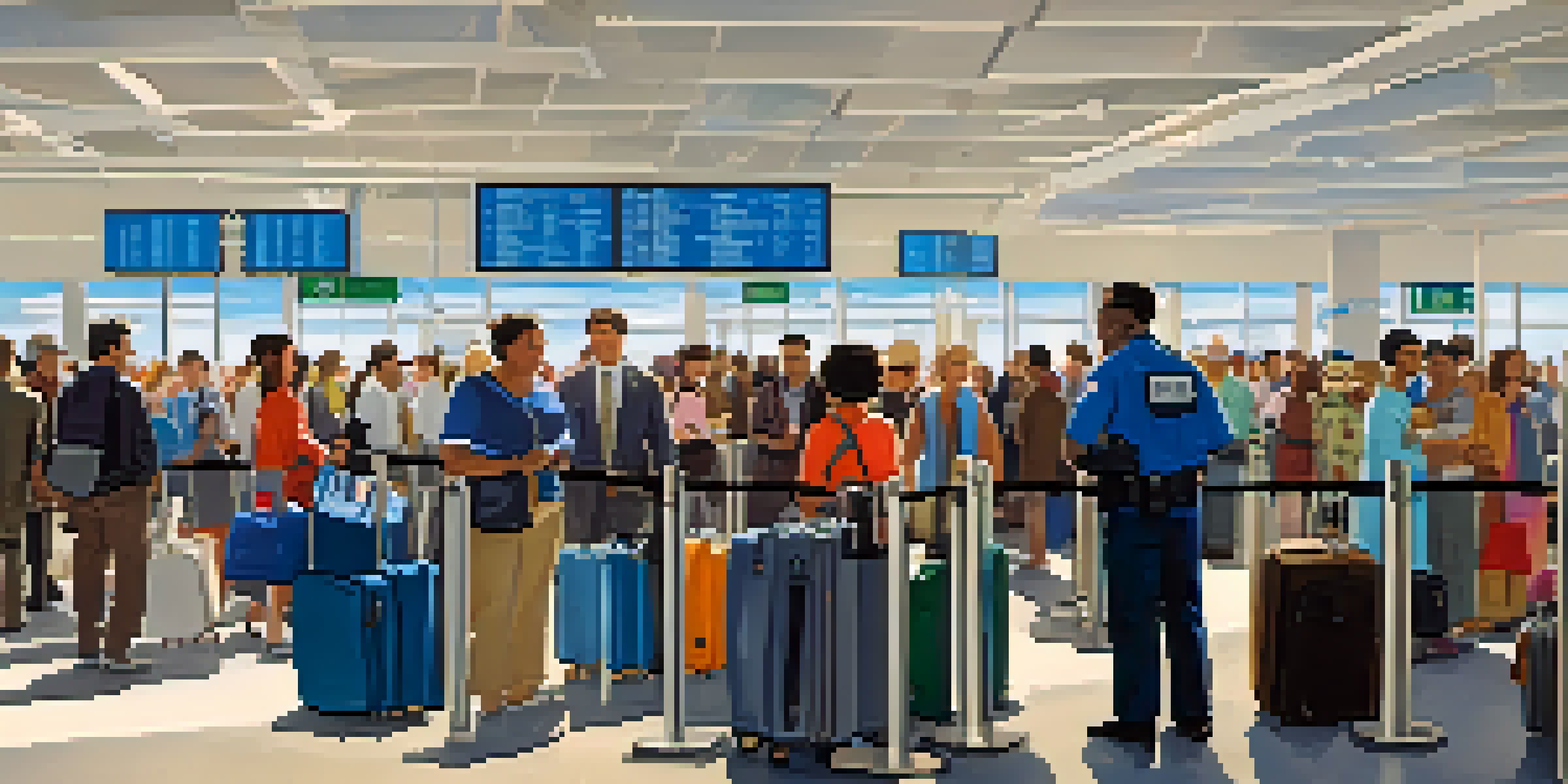Navigating Security Checks: What You Need to Know

Understanding Security Checkpoints Before You Arrive
Security checkpoints are a necessary part of modern travel, designed to keep everyone safe. Before arriving at the airport, familiarizing yourself with what to expect can help ease travel anxiety. Knowing the layout of the security area can also save you time, allowing you to navigate smoothly to your gate once through security.
The journey of a thousand miles begins with one step.
Every airport may have slightly different procedures, so it’s a good idea to check online for specific details related to your departure airport. This could include information on wait times, prohibited items, and any special protocols that may be in place. Understanding these nuances can help you feel more prepared and confident when you arrive.
Ultimately, being informed contributes to a more relaxed travel experience. Just like studying a map before a road trip, understanding security checkpoints helps you avoid unnecessary hiccups and ensures you start your journey on the right foot.
What to Pack for Easy Security Screening
Packing strategically can significantly ease your experience at security checks. Opt for a carry-on bag that allows easy access to your essentials, like your ID and boarding pass. Organizing your items, such as liquids in a clear, resealable bag, can help you breeze through the screening process without delays.

Remember, there are restrictions on items like sharp objects and certain liquids. By packing these items in your checked luggage instead, you'll avoid the frustration of having them confiscated at security. It’s always wise to double-check the latest regulations for the airline you’re flying with, as they can vary.
Prepare for Security Checkpoints
Familiarizing yourself with airport security procedures can reduce anxiety and save time during your travel.
Think of it as playing a game of Tetris: the way you pack can determine how smoothly everything fits together during security checks. Being organized not only saves you time but also keeps you stress-free as you prepare for your flight.
Dressing for Success: Clothing Choices Matter
The clothes you wear to the airport can impact your experience at security. Opting for slip-on shoes and minimal layers makes it easier to remove items during screening. Think of it as preparing for a mini workout; you want to ensure you're comfortable and ready to move quickly.
Preparation is the key to success.
Avoid belts, jewelry, and clothing with excessive metal, as these can trigger alarms and slow down the process. Instead, consider clothing with pockets where you can easily store your phone and keys. A light jacket can be handy too, as it can be removed and placed in the bin without hassle.
Dressing smartly not only enhances your comfort but also shows respect for the security process. It’s like choosing the right gear for a hike; the more prepared you are, the more enjoyable the journey will be.
Navigating the Lines: Patience is Key
Security lines can be long and daunting, but patience is truly a virtue in these situations. Instead of stressing over the wait, use this time to relax and mentally prepare for your trip ahead. Bring a book or some music to keep yourself entertained while you wait.
Be aware of the flow of the line and listen for announcements, as these can provide important updates. Engaging with fellow travelers can also lighten the mood and make the wait feel shorter. Remember, everyone is in the same boat, so sharing a smile can go a long way.
Pack Strategically for Ease
Organizing your carry-on and adhering to item restrictions can streamline your experience at security checks.
Think of the security line as a necessary rite of passage; while it may feel tedious, it is a crucial step toward your adventure. Maintaining a positive attitude can transform the experience from a hassle into an opportunity to connect with others.
What Happens During the Screening Process?
Once you reach the screening area, you’ll need to place your carry-on items and personal belongings in bins for scanning. This process is straightforward, but it helps to know what to expect. You’ll be asked to walk through a metal detector or body scanner, which is standard procedure to ensure safety.
If you set off an alarm, don’t panic. Security personnel are trained to handle these situations professionally and discreetly. They may conduct a quick pat-down or ask you to step aside for additional screening, which is all part of maintaining security.
Understanding this process can help ease any worries you may have. Just like in a game of Simon Says, following the instructions can lead to a smooth outcome and prepare you for the next leg of your journey.
Handling Special Circumstances: Families and Disabilities
Traveling with children or if you have a disability can present unique challenges at security checkpoints. Families often have additional items, like strollers or toys, which may require extra attention. It’s best to arrive earlier than usual to accommodate these extra steps in the process.
For travelers with disabilities, TSA offers a range of services designed to make the screening process as smooth as possible. It’s recommended to inform security personnel of your needs ahead of time, as they are trained to assist you in a respectful and efficient manner.
Be Patient in Security Lines
Maintaining a positive attitude while waiting in security lines can transform the experience into an opportunity for relaxation.
Think of it as a team effort; everyone at the airport is there to help you. Being aware of the resources available can help make your experience more pleasant and ensure that your journey is as stress-free as possible.
Final Steps: Collecting Your Belongings
After passing through security, the final step is to collect your belongings. This is often the moment when travelers rush to gather their items, but taking a moment to double-check can save you from leaving something behind. Patience here can prevent a frantic search later.
Make sure to gather all your bins and items, especially anything that may have been placed on the conveyor belt. The last thing you want is to leave behind your favorite travel pillow or, worse, your passport. A quick scan of the area helps ensure nothing is left behind.

Think of it as wrapping up a project; just as you wouldn’t leave loose ends, make sure you have everything in hand before heading to your gate. This little habit can save you a lot of trouble and help you focus on what really matters—enjoying your trip!